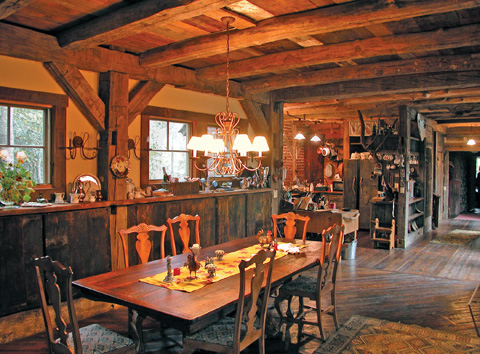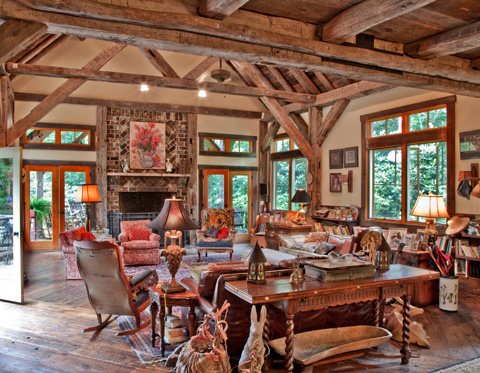The deep texture and rich colors of reclaimed wood afford distinctive log homes and their discerning owners the opportunity to step out of the crowd. Old-growth timber, recovered from a cabin built during pioneer days or given new life when rescued from a commercial building that was bustling a century ago, adds flair to a log home like nothing else.
“The actual industry term that predates the modern ecological push is ‘antique materials,’” explains Allen Halcomb, president of MossCreek, a custom design firm based in Knoxville, Tennessee. “The wood may come from beams or flooring or whatnot out of an old factory, older log homes, or even tobacco barns. Some pieces come with provenance, while others may not. They may be from a pre-Revolutionary War log cabin or an Amish barn in Pennsylvania.” Halcomb says the appeal of reclaimed wood also lies in its intrinsic value. Modern timber and wood products purchased from a big box store may be beautiful in their own right, but antique material has a distinctive grain pattern and a look that cannot be duplicated.
“The wood is from an older growth species of tree,” relates Halcomb. “Ninety-nine percent of the trees in what is now the United States were cut down by the early 1900s, so all the trees you and I know are new growth. Old growth has denser wood, more color and texture to it, and it is largely more insect resistant. So, it is an altogether different wood with a different patina. You can get a lot of color, texture, and durability and even a virtually maintenance-free exterior if you like the color gray.”
A small but enthusiastic segment of the log home market actively seeks reclaimed wood for both exterior use and distinctive interior options. The former life of reclaimed wood leaves telltale footnotes to its history, adding character in each nail hole, check, or weathered line. A log home design may include barn board in the kitchen or an antique hand railing, and sourcing the material has been elevated to something of an art form.
“An entire industry exists out there, and it starts at the spotter level,” comments Halcomb. “These individuals become aware of properties such as old cabins or factories that can be purchased outright or have an option placed on them with a small amount of money. Then they make a deal with a picker who will buy the rights from the spotter.”
“Pickers,” he continues, “have contacts with retailers and makes them aware of what they find. Retailers either buy direct or take over the option. Then come guys like us with a division called MossCreek Elements, which provides the sourcing and design services to our customers. We have a lot of fun taking clients shopping for these items—somewhere off the beaten path.”

At Mountain Lumber Company of Ruckersville, Virginia, buyers source materials from local vendors, contractors dismantling older structures, and wood brokers specializing in antique materials.
“Reclaimed wood is a perfect fit for a log cabin,” notes George Chesebro, a buyer with Mountain Lumber. “Reclaimed material can span a range from rustic to refined and elegant. The history of decades of use and nature’s effects give this material a look all its own. Mountain Lumber provides a wide array of products to fill the log home builder’s needs. Products such as flooring, rough lumber for cabinetry, trim work, and exposed beams are available.”
Log home owners who incorporate reclaimed wood are creating pieces of artwork that will rest on permanent display in their residences. Creativity is given free rein, and the interpretation of wood grain, flow, and texture becomes an expression of the owner’s personality.
“Your imagination is the limit when it comes to reclaimed wood,” Chesebro adds. “We can accomplish in reclaimed materials most any detail in your log home that you can envision.”
Of course, a premium price accompanies antique material due to its relative scarcity, additional labor, and competition for the highest quality pieces. The buyer’s construction budget and the volume of the purchase influence the pricing and decision-making process. Estimates of the anticipated upcharge compared to standard wood products range from about 10 percent to more than double.
Nevertheless, the thrill of the hunt and pride in the finished product make the investment in reclaimed wood worth every penny for that passionate portion of the log home market.

